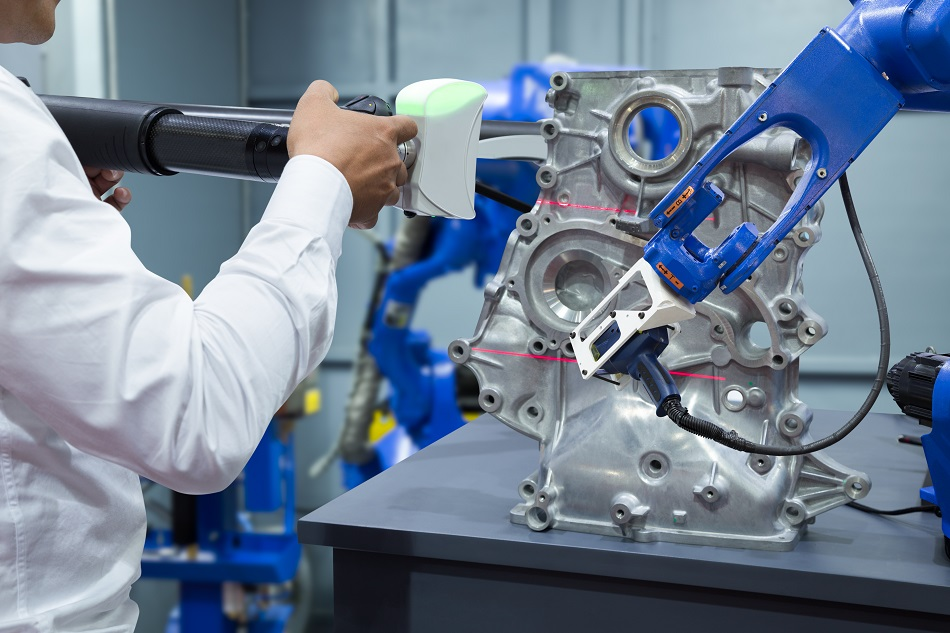
Image Credit: Suwin/Shutterstock.com
Over the past few decades, industrial robotic automation has gone from cutting-edge technology to industry-standard equipment.
Most automated machines function using multiple contacting surfaces that are in motion. For durability and efficiency purposes, the friction between surfaces should be minimized in most cases. The study of friction between interacting surfaces is called ‘tribology’.
Principles of tribology are critical to the design and diagnosis of industrial automation. For minimizing friction, tribology is used to develop all types of sliding and rolling bearings.
For rolling bearings, tribology is applied to determine the lubricant to be used, the form that the bearing should take, the surface finish, and the types of materials to use. Tribology is also applied to determine friction, subsequent temperature increase, and the lifetime of both the bearing and the lubricant.
Robotics bearings are designed by using highly advanced tribological computer models, prototyping, and comprehensive laboratory trials.
Whenever highly accurate motion control is required by a robotic system, friction is a major consideration for the designer. They must address various theoretical, potential, and practical issues.
The effects of friction are especially important for automated industrial robots. According to research, friction can cause up to 50 percent of errors in some heavy industrial applications.
An inadequate or missing friction-mitigating device in an automated system may result in considerable tracking mistakes, particularly at low speeds, along with the sticking, slipping, jamming, and wedging of parts.
There are several solutions available to address unwanted friction in robotic automation. These solutions take in to account various types of friction and the various models used to represent it.
For any given design situation, there are typically multiple strategies available to get rid of or substantially reduce the effects of friction in the automated system. The selection of a friction solution is also strongly affected by factors like cost and the availability of actuators, sensors, and other hardware.
Designers must also consider software solutions for reducing friction, with an eye on reducing the constraints attributed to computational load.
In addition to considering the tribology-related factors of the robotic system itself, designers must also consider friction during the various assembly operations performed by the robotics that they design.
Theoretical models of friction during assembly operations cannot fully project with 100 percent accuracy what may occur during any given assembly process because there are many factors that can have an impact on friction during assembly. The theoretical models in use are approximate and put forward solutions in the context of ideal conditions.
Tribology 4.0
The rise of analytics, Big Data, artificial intelligence, the Internet of Things, and other 21st century technologies has led many to say that modern society is currently in the Fourth Industrial Revolution, or Industry 4.0.
In the context of Industry 4.0, tribology has only become more sophisticated and advanced, particularly in respect to robotics and automation. The relationship between tribology and connected digital technology is growing stronger by the year.
State-of-the-art robotics are capable of tracking and modifying various facets of their operation, thanks to the capabilities of modern sensors and actuators. Using tribological principles, smart systems can enhance the performance of industrial automation, reduce friction, and reduce wear.
Real-time information associated with friction, vibrations, wear, and temperature can be documented and used to maintain and enhance the performance of tribological systems.
The result is that the efficiency and dependability of entire machines are elevated. For example, sensors can track the conditions of contacting surfaces and the state of lubricant in a machine. A communication system can simultaneously deliver tribological information for quality control purposes and potential corrective actions.
The use of actuation mechanisms presents the possibility of shifting the geometry of a tribological part as desired. The usage of a controllable or active lubrication can allow for additional reductions of friction and vibration, improving the whole performance of the system.
The qualities of controlled lubricant can be manipulated by using materials such as electro-rheological and magneto-rheological fluids. Active management of friction can be realized by the manipulation of both surface geometry and fluid viscosity.
Down the road, technology founded on micro- and nano-tribology, along with the synthesis of new materials, will result in ultra-slick and next-generation materials that can maintain very low friction and wear levels.
Sources and Further Reading
Disclaimer: The views expressed here are those of the author expressed in their private capacity and do not necessarily represent the views of AZoM.com Limited T/A AZoNetwork the owner and operator of this website. This disclaimer forms part of the Terms and conditions of use of this website.